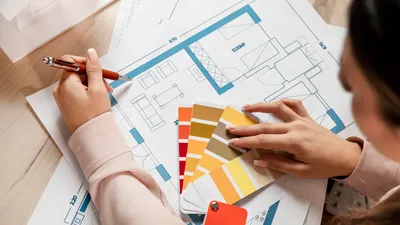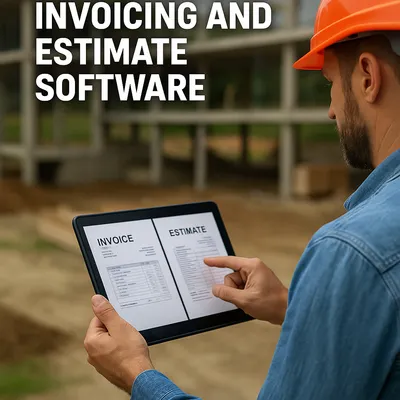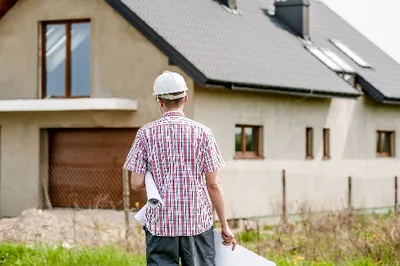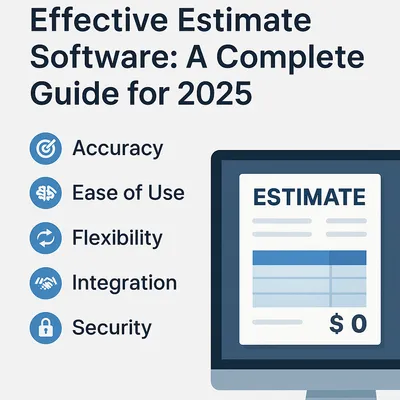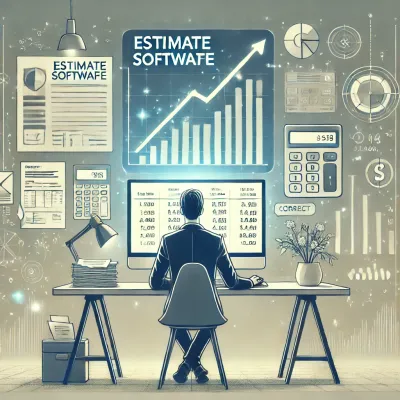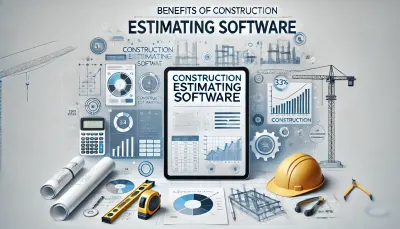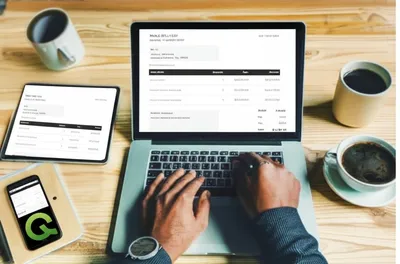The Hidden Cost of Accuracy: Guide to Drywall Estimate Software (2026 Edition)
Discover how to estimate and invoice drywall jobs accurately using modern estimate software. Stop profit leaks, reduce errors, and get paid faster with a 2026 workflow.
by
Eng. José Manuel Siso Colmenares • 11/19/2025
The Hidden Cost of Accuracy: Guide to Drywall Estimate Software (2026 Edition)
You just wrapped a 2,000 sq. ft. drywall hang + tape job. You’re tired, dusty, and ready to get paid—so you do what most contractors still do:
You scribble numbers on a sheet of notebook paper, take a photo, and text it to the GC.
Three weeks later… nothing.
Worse—you discover you forgot to charge for corner beads, Level 5 prep, and two hours of scaffolding setup.
You didn’t just work for free. You paid to work.
If this sounds familiar, you’re not alone. Recent research shows that inaccurate estimates are a major profit killer. One analysis found that about 30% of construction companies regularly experience cost overruns because profits end up lower than expected from their estimates, and another study attributed roughly 27% of project cost overruns directly to flawed estimates and bad data. gobridgit.com +1.
This guide will show you how to stop bleeding profit, eliminate “guesstimates,” and use modern drywall estimate software like QuickAdmin to build precise estimates and airtight invoices.
By the end, you’ll have a bulletproof system to:
Quote accurately
Protect your margins
Justify your prices
Get paid faster
Look more professional than your competitors
Let’s begin.
The Profit Leak Most Drywall Contractors Don’t See Coming
The Story Every Drywaller Knows Too Well
Picture this:
You quote a flat rate of “$1.80 per sq. ft. installed + finished” because that’s what everyone else does.
But here’s the truth:
A square foot of garage drywall is NOT the same as a square foot of vaulted ceiling drywall.
Yet most contractors bill them the same.
The cost difference is massive:
| Area | Realistic Labor Difficulty | Profit Impact if Underpriced |
|---|---|---|
| Standard 8’ wall | Normal | Low |
| Garage lid | Medium | Medium |
| Vaulted ceiling | High | High (20–30% loss) |
| Level 4 finish | Normal | Low |
Level 5 finish is significantly more labor-intensive — cost guides commonly price it around 25–40% higher than a standard Level 4 finish, mainly because of the extra skim coat and sanding steps.
If you aren’t adjusting per condition, your “profit” is actually disappearing.
2025–2026 Industry Data
According to HomeAdvisor (2025) and RSMeans (2026):
Material volatility: drywall and other building materials remain elevated in price — gypsum products, for example, rose about 44.6% over 2021–2022 and only slipped by around 2% in 2023, so your estimates should always include a clear validity date.
Level 5 labor rates increased 19% since 2023
Waste factor: many drywall guides — including The Spruce’s step-by-step drywall estimating tutorial and popular calculators such as Inch Calculator — recommend adding 10–15% for waste and odd cuts, and complex layouts or high-end work can push waste even higher if you don’t plan your board layout carefully, a cost that is often left unbilled.
Studies on construction performance show that inaccurate estimates and bad project data are a major source of rework and cost overruns, steadily eroding profit margins. As ConWize’s analysis of estimate errors explains, even a seemingly small 3% loss in margin from estimating mistakes can materially impact annual profit for a specialty contractor.
This is exactly why price-per-sheet is a broken model in 2026.
Why Your Price-Per-Sheet Formula Is Failing (Open Loop Closure)
Most drywallers use a fast formula:
“X per sheet” or “X per sq. ft.”
It feels simple—but it hides essential details.
Let’s break down the three silent profit killers.
1. Complexity Multiplier: Level 5 vs Level 4 vs Problem Walls
A Level 5 finish requires:
Full skim coat
Lighting sensitivity correction
Higher sanding time
Specialized labor
According to the Gypsum Association:
Level 5 requires 30–50% more labor than Level 4.
If your estimate doesn’t reflect this, your Level 5 jobs are draining profit.
2. Waste Factor Miscalculations
Standard waste is:
10–12% on simple rooms
Up to 20% in irregular layouts
25%+ on high-end custom homes with cut-heavy details
If you estimate 100 sheets and buy 115… someone must pay for the extra 15.
It should not be you.
3. Specialty Materials Forgot in Estimates
Drywall contractors frequently miss:
Bullnose or L-bead
Fire-rated (Type X) board
Moisture-resistant panels
Soundproofing (QuietRock, Green Glue)
Access panels
Corner bead variations
Blocking and backing labor
Every missed line item is money lost.
Phase 1: Building Rock-Solid Drywall Estimates (Where Profit Is Made)
An invoice gets you paid. An estimate ensures you get paid fairly.
Drywall estimate software like QuickAdmin forces a structured approach that eliminates guesswork.
1. Materials: Break Them Down or Lose Money
Here’s what top-performing contractors include:
A. Gypsum Board Types
½” regular
⅝” Type X
Mold-resistant
Lightweight
Sound-rated
Ceiling board
Each has unique costs, weights, and waste profiles.
B. Mud & Tape (Often Underestimated)
Formula: a common rule of thumb is to use about 0.053 lbs of joint compound per square foot of drywall.
Example: 2,000 sq. ft. job → 106 lbs of mud → 2–3 buckets
C. Corner Beads & Accessories
Always itemize:
Metal corner bead
Bullnose
Vinyl bead
Tear-away bead
L-beads
J-beads
Fire-stopping caulk
Backing time
A GC cannot argue with a detailed list.
🧹 D. Cleanup & Prep
Most drywallers forget to charge for:
Floor protection
Plastic
Taping doorways
Cleanup bag disposal cost
Charge for it. Every time.
2. Labor: The Most Variable Factor in Drywall
Modern estimate software separates labor into categories:
A. Hanging Labor
Standard: 4–6 boards/hour/man
Difficult ceilings: 2–3 boards/hour/man
B. Taping & Mud Work
Level 4: moderate
Level 5: 30–50% more time
C. Haul Charge / Access Difficulty
Examples:
Two-story carry: +10–12%
No elevator (apartments/condos): +15–20%
Scaffolding setup: +$150–$350 flat
Tight staircases: +8–10%
D. Drive Time
Drywall finishes require multiple trips. Charge for them.
3. Hidden Costs Most Contractors Forget
These account for 80% of invoice disputes:
Hidden Cost Typical Contractor Error Solution
| Hidden Cost | Typical Problem | What Software Lets You Do |
|---|---|---|
| Waste factor | Never added | Add 10–15% automatically |
| Matching textures | Included “somewhere” | Separate line item |
| Priming prep | Thrown in with finishing | Bill as its own task |
| Travel / multiple trips | Not billed | Minimum trip charge or hourly |
| Fasteners & hardware | Ignored in pricing | Itemized with rules of thumb |
| Ceilings vs walls | Charged the same rate | Higher rate or factor for ceilings |
Phase 2: Manual vs Digital – The Cost of Choosing the Wrong Tool
You essentially have three classes of tools:
- Pen & paper
- Excel / Google Sheets
- Specialist estimating + invoicing software (QuickAdmin, Joist, InvoiceSimple, etc.)
Let’s be honest about them.
Comparison: Manual vs Excel vs QuickAdmin
| Feature | Pen & Paper | Excel/Sheets | Joist | InvoiceSimple | QuickAdmin |
|---|---|---|---|---|---|
| Upfront cost | Free | Free | Subscription | Subscription | Free / Freemium |
| Learning curve | Low | Medium | Medium | Low | Medium (trade-focused) |
| Saved price list / catalog | No | Manual | Limited | Limited | Full item library |
| Estimate → Invoice | No | Manual copy | Yes | Yes | 1-click conversion |
| Job / cost code tracking | No | Complex | Limited | Very limited | Built-in |
| Mobile + offline (PWA) | No | Poor | Native app | Native app | PWA, works like an app |
| Home Depot price checks | No | No | No | No | Yes (limited free queries) |
Competitor landscape: who’s who
You’ve probably heard of:
- Joist – Clean interface, popular in residential work. Often pushes homeowner financing features that you may not need if you’re mostly B2B.
- InvoiceSimple – Great for very simple service invoices, but advanced customizations and multi-job workflows get locked behind higher-priced tiers quickly.
- Buildertrend – Powerful, but feels like overkill (and expensive) if you mainly need estimates + invoices + time tracking for a small crew.
QuickAdmin aims to sit in the middle:
- Built for contractors (not just generic “small businesses”)
- Free plan with multiple estimates + 1 invoice/month
- Estimate → Invoice in one click
- Time tracking, jobs, and basic cost codes
- Progressive Web App (PWA) so you can use it on-site without installs
To reinforce topical authority, you can link deep into your existing content:
- Benefits of construction estimating software
- How estimate software improves financial planning for small businesses
- Why PWA is the future of billing, estimating, and time tracking
Phase 3: Drywall Invoicing That Gets You Paid Faster
A vague invoice = payment delays. A detailed invoice = paid on time.
1. Branding & Header
Include:
Logo
License number
Contact information
Project name
Branding = professionalism = faster payment.
2. Scope of Work (The Most Important Section)
Bad: “Drywall labor – $5,000.”
Good:
Installation of ½” lightweight drywall in master suite (1,200 sq. ft.)
Ceiling board installation at ⅝” Type X
Taping, mudding, sanding to Level 4 finish
Corner bead installation: bullnose finish
Surface prep & cleanup
No one disputes a detailed invoice.
3. Payment Terms (Protect Yourself)
Best practices:
Net 15 or Due Upon Receipt
Late fees: “1.5% per month on overdue balances”
Early pay discount: “2% if paid within 5 days”
Include lien warning (check local laws)
4. Freshness Signal: Updated 2026
Material markets are volatile.
Add:
“Estimate valid for 15 days due to gypsum and lumber price fluctuations.”
Protects your profit from inflation.
Real-World Scenarios (With Original Calculations)
1. Basement Project – 2,000 sq. ft.
Standard walls
Ceilings at 8 ft
Level 4 finish
Total labor hours: 37–45 Total materials: 95–110 boards Total price: $3.20–$4.80 sq. ft.
2. Commercial TI – Specialty Fire-Rated Board
⅝” Type X
Sound-damping assemblies
Level 5 finish
Labor increase: +30–50% Material cost increase: +18–30%
3. Drywall Patch – The Mistake Most Contractors Make
Never charge per sq. ft.
Minimum charge: $250+ Why? Drive time + setup + cleanup + hot mud drying.
Step-by-Step: How to Create a Drywall Estimate & Invoice in QuickAdmin
- Sign Up (Free)
Go to quickadminsoftware.com → Create account.
- Add Client
Store once, reuse forever.
- Create Estimate
Add materials
Add labor
Add markup
Send instantly
- Convert to Invoice
One click → no retyping.
- Send & Track
Get notified when the client opens the invoice.
Conclusion: Accuracy Is a System—Not a Guess
The drywall industry is changing. Margins are thinner. Materials fluctuate monthly. Labor costs are rising.
The only contractors who thrive in 2026 are the ones who estimate accurately and invoice professionally.
Tools like QuickAdmin make that possible—even on the free plan.
👉 Ready to stop losing money? Create your first free estimate and invoice today: https://quickadmin.app/signup
FAQ
- What is the best drywall estimating software in 2026?
QuickAdmin offers the best free plan for contractors needing estimates + invoices + job costing without a high subscription cost.
- What’s the difference between Level 4 and Level 5 finish?
Level 5 finish is significantly more labor-intensive—cost guides commonly price it around 25–40% higher than a standard Level 4 finish
- How much should I charge for drywall labor?
Typical range: $1.60–$3.50 per sq. ft., depending on complexity and finish level.
- Should I include materials on the invoice?
Yes—either itemized or blended into a lump sum. Itemization reduces disputes.
- How do I estimate drywall patch repairs?
Charge a minimum trip fee ($250–$350). Never charge by sq. ft.
- Does QuickAdmin integrate with QuickBooks?
Yes, QuickAdmin supports QuickBooks Online for syncing invoices.


